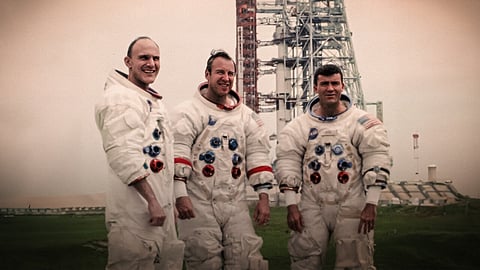Apollo 13: Survival Review: Engaging documentary of an oft-explored space rescue mission
Apollo 13: Survival(3 / 5)
Peter Middleton’s Netflix documentary Apollo 13: Survival tackles some very famous subject matter. Apollo 13’s mission to the moon and the subsequent glitch that led to a nerve-wracking rescue operation had much of the world in its thrall in April 1970. At the time, space exploration was relatively novel, with only a handful of successful flights. The event went on to inspire countless interviews, documentaries, films, and a non-fiction book co-authored by Jim Lovell, the commander of the mission. Ron Howard would use the aforementioned book (Lost Moon: The Perilous Voyage of Apollo 13) as source material for his critically acclaimed adaptation starring Tom Hanks. Despite there being so much in public consciousness surrounding Apollo 13, Middleton’s documentary combines rare, never-seen-before archival material with representational footage to present an even more in-depth look at the days leading up to the mission, all that happened on board, and the daring operation to bring the astronauts back unharmed. Perspectives are seen from the crew, family, and ground control.
Director – Peter Middleton
Cast - Jim Lovell, Jack Swigert, Fred Haise, Marilyn Lovell, Ken Mattingly, Gene Kranz
Streaming On - Netflix
As part of NASA’s program, Apollo 13 is scheduled to be the third vessel to land on the moon. The mission is headed by space veteran Jim Lovell. Ken Mattingly and Fred Haise are part of the remaining three-member crew; the former, tasked with piloting the command module of the flight, and the latter, the lunar module. In the exciting lead-up to April 11 (take-off), Ken is replaced by Jack Swigert, owing to an exposure to German measles. This is the first visit to space for both Swigert and Haise. Interviews are conducted with each of the crew, with Lovell recalling his varied experiences of space travel and the moon. The men aren’t superstitious, and yet, the media focusses on the contentious number of the vessel and its take-off time of 13:13. Haise even wishes they could launch on Friday, the 13th. The mood is not as jocular in the Lovell household, with Marilyn, Jim’s wife, apprehensive. Multiple interviews conducted with her capture a nervous energy. She is undoubtedly proud but isn’t willing to overlook the inherent risks. There is a 50-50 chance of them returning. Her statement, “Nothing really prepares you to be an astronaut’s wife,” is telling. With all the fame and fanfare come the emotional turmoil of never being absolutely certain of anything in space. Apollo 13 launches as planned from the Kennedy Space Center in Florida. But on April 13, 1970, two days into the flight and 200,000 miles from Earth, an electrical failure occurs in the vessel’s service module, rendering it useless. The crew must now work nonstop with ground control to figure out a way back, with time and resources (oxygen, potable water and fuel) in short supply.
It is indeed challenging to create a fresh documentary for an event with a deluge of verified information already in the public domain. The Apollo 13 space rescue mission was documented extensively during that era and in the years leading up to Lovell’s book (1994) and Howard’s film (1995). Never-seen-before footage by itself, be it home movies and interviews featuring Jim’s wife and kids, audio and video recordings (from Apollo 13, Mission Control, and their tense two-way communication), would not be sufficient to make it utterly absorbing. What Middleton achieves, with expert editing, is the building of perfect tension. And therein lies the difference. While fictional films based on fact have the option of creative license, it is much harder for a documentary format that’s bound by the confines of truth.
Once the electrical failure is confirmed by Jack Swigert, and reiterated by Jim Lovell, with the now-famous line, “Ah, Houston, we’ve had a problem," it becomes a race against time for the crew’s safe return. Switching from the Mission Control room headed by Lead Flight Director Gene Kranz to the space vessel in real-time, the sheer anxiety is palpable. When Marilyn Lovell is informed of the situation, this goes up several notches. A sombre ground control unit works round the clock with instructions, improvising on the go. The crew follows them to the tee, providing minute-by-minute updates about the ever-changing status. The very likelihood of a disaster is on everybody’s mind, but apart from the media, no one utters a word. Commander Lovell and his team must move quickly to the lunar module, which will now serve as a lifeboat. The entire vessel has to do a loop of the moon before making its way back home. The command module has to be powered down so as to conserve energy to re-enter Earth’s atmosphere. The lunar module is designed only for two crew members, containing two days’ worth of lifesaving supplies. The destination is still four days away. Under the immense pressure of circumstance, NASA’s on-ground support team has to come up with a viable plan that protects their astronauts.
If there is one criticism that can be levied against Apollo 13: Survival, it is that there are little to no perspectives to be had from the families of the other crew members. The attention is focused solely on Jim’s wife, Mailyn, and his daughters, Susan and Barbara. While it is understood why that may be the case (he is the veteran commander of the mission, after all), it would have been interesting to witness what the other families were thinking at the time. It is hard to ascertain whether permission was given to release their interviews/videos, if there were any, to begin with, but it would have certainly provided a more rounded perspective.
All things considered, Apollo 13: Survival engages with access to rare footage, editing the available material in such a way as to re-create the sheer tension of the expedition for a modern audience.


